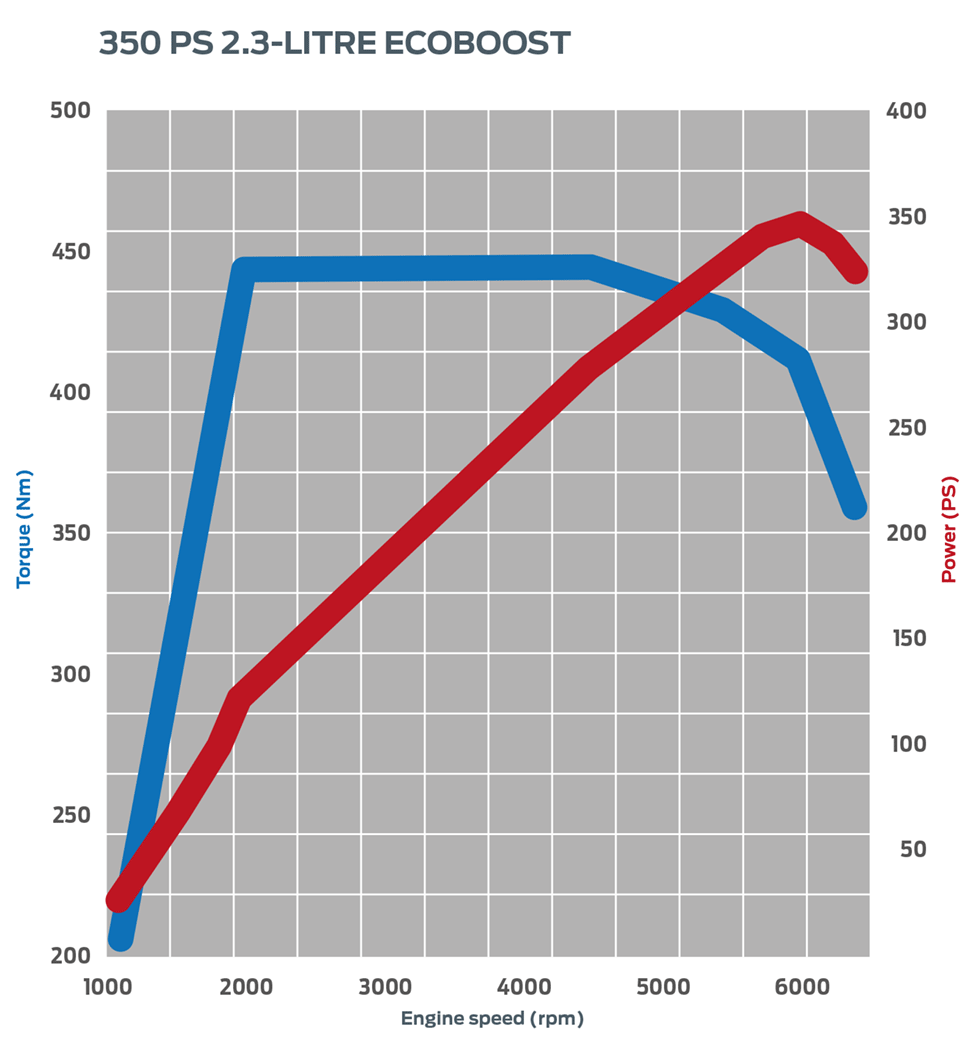Ecoboost 2.3 engine
The Ford Focus RS MK3 has a 2.3-litre, four-cylinder Ecoboost engine (also shared with the 2014 Mustang) that can reach a notable top speed of 165 miles-per-hour (MPH), and can reach 0-60 in 4.7 seconds.
The engine power stands at 345 brake horsepower (BHP), which is a significant performance improvement on the last two RS models. The MK2 had 301 BHP, whilst the MK1 only had 212. The special edition RS500 is the only one of the models that can dispense a similar amount of power as the MK3. Ford have also reduced the emissions on the MK3 model by twenty percent, with the brand making sure that their new power model is in line with current EU emissions standards.
Engine Specification
- 345bhp
- Top speed of 165mph
- Configuration: 2.3 litre Ecoboost inline-four
- Construction: Aluminium block and head with integrated exhaust manifold
- Valvetrain: DOHC, four valves per cylinder, twin independent variable camshaft timing
- Fuel delivery: Direct furl injection
- 0-60 in 4.7 seconds
- 324lb of torque (2000 – 4500rpm)
- 347lb of torque (available for 15 seconds – overboost)
- Maximum free-rev limit of 6800rpm
- Compression ratio of 9:4:1
- Output: 350ps at 6,000rpm, 440Nm at 2,000-4,500rpm
Focus RS Power Graph

How it Works
The Ecoboost engine combines turbocharging and direct fuel engine, and is much more economical whilst still retaining speed and power.
The RS engine incorporates direct fuel injection with twin independent camshaft timing (variable) and a twin-scroll turbocharger.
The 2.3-litre Ecoboost engine has an additional 23lb of torque available as part of its overboost capacity, taking the available torque from 324lb to 347lb for a maximum of 15 seconds at a time.
Ford Focus RS vs. Mustang
Considering both of Ford’s exciting models have the 2.3-litre Ecoboost engine technology, there are still some differences between the vehicles. The RS engine’s best feature is a low-inertia, twin-scroll turbocharger with an improved compressor (to boost airflow) and an improved and slightly larger intercooler.
Ford has considered the engine right down to its materials, designing the cylinder head from an upgraded alloy, and mounting it on a strong head gasket. To reinforce the strength of the engine, the cylinder block has a durable cast-iron lining for maximum protection. The cylinder head and gasket were both created by high-performance automotive engineering company Cosworth.
The Mustang is also available in a 2.3-litre Ecoboost variant, producing 310bhp and 320lb of torque.
Ecoboost Function
The turbocharged Ford EcoBoost engine intakes a larger amount of air than the average engine, which in turn increases engine power. The turbocharging system cleverly increases power without consuming a higher amount of fuel.
How Using Drive Modes Affects the Engine
The four drive modes on the RS (Normal, Sport, Track and Drift) each have a different bearing on the performance of the engine, all-wheel-drive, steering, suspension, engine stability control (ESC) and the exhaust.
Normal mode is designed for everyday driving, and the engine and other components are all set to default in this particular mode. The RS Sport Mode makes the engine more responsive and dynamic.
The Track setting switches the engine to Sport mode, and Ford stress that this mode is particularly reserved for off-road driving situations.
Drift Mode directs the rear-drive-unit (RDU) to distribute maximum engine torque to the outside wheels to change the direction of motion.
How power compares to rivals
Technical vehicle experts have tested the Ford Focus RS’s to see how it stacks up against its rival models:
Honda Civic Type R
The Honda Civic Type R has a 2.0-litre i-VTEC Turbo Engine which can go from 0-60 in 5.7 seconds, and has a maximum speed of 168mph. The engine can also deliver up to 310PS.
Audi RS3
Audi’s popular RS model features a 2.5-litre TFSI engine, combining direct petrol injection with turbocharging. The five-cylinder engine reaches 0-62mph in 4.3 seconds, and has a maximum speed of 155mph.
Mercedes A45 AMG
The Mercedes A45 AMG model has a 2-litre engine with 376bhp and a four-cylinder turbo motor.
Read more on this with our Hot Hatch Group Test feature
Ecoboost Engine: the History
The range of Ecoboost engines were especially designed by Ford and FEV engineering to set the brand apart from their competitors. Since its introduction to the market, the Ecoboost engine has featured in different variations on a host of Ford models, including Fiesta, B-MAX, EcoSport, New Focus, New C-MAX, All-New Mondeo, Tourneo Connect, Transit Courier and Transit Connect. Most of the models listed utilise Ford’s very eco-friendly 1.0-litre engine. The Focus ST and Mustang have 2.0-litre and 2.3-litre variants, whilst the Fiesta ST has a 1.6-litre turbo version.
The technology speaks for itself, with the 1.0-litre variant winning engine of the year in 2014 for the third time consecutively.